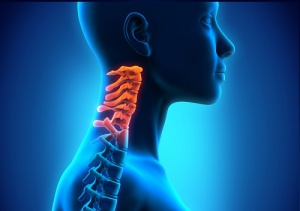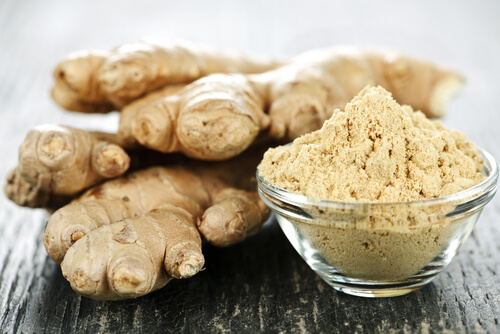Cervicogenic Dizziness: Causes and Remedies


Written and verified by psychologist Valeria Sabater
Suffering from cervicogenic dizziness is without a doubt an ailment as uncomfortable as it is paralyzing. As a result, it can slow down our daily life, keep us from working, or affect our normal responsibilities.
Tingling, chills, a feeling of cold, tension at the nape of the neck, dizziness are the most common symptoms. Unfortunately, in many cases, these become chronic.
The vertebrae that we normally call the cervical vertebrae are responsible for maintaining our heads in an upright position. They are made up up seven pieces where stress commonly concentrates. Poor posture, fatigue or anxiety can lead to those problems inevitably associated with the terrible dizziness, which can develop into what we call cervicogenic dizziness.
See also: 10 Habits that Cause Back Pain
Causes of cervicogenic dizziness
- Neurovascular compression due to degenerative changes in the vertebrae, producing an inevitable rigidity.
- Conflicts between the information of the movement of the neck and the information of the inner ear and vision. This produces an unbalance in which we feel a continual instability. It’s as if we were all of a sudden in a moving vehicle. Consequently, our eyes can see movement, but the liquid in the inner ear and the atlas and axis vertebrae remain rigid. They don’t adjust, and, as a result, produce an imbalance and the resulting dizziness. All of that makes us lose confidence when the time comes to do many activities in our daily life. We feel a compression and we refuse to even move our neck, even when we feel a little better. We are scared and this, in turn, can cause even more dizziness.
See also: 5 Health Problems that Cause Back Pain
Remedies for cervicogenic dizziness
Recommended treatments
- Hot cold treatment. First of all, we’ll apply a bag of ice for three or four minutes, followed by hot showers, hot compresses, or hot water bottles. Note that you shouldn’t leave a heating pad on your skin throughout the night.
- As much as possible, we will avoid intense physical activity. We must avoid inflaming the cervicogenic area further.
- Rosemary or lavender water baths are very beneficial. They act as anti-inflammatories and are very useful in treating muscle spasms, lower back pain, cervical pain, etc.
- We will attempt to keep a regular sleep cycle. In this way we help the stability of the body, and reduce stress levels.
- Physical therapy is also very beneficial. Doing aerobic exercises will help our body and nervous systems the achieve the mobility and dynamics necessary to return to wellness. It is also necessary to soften the rigidity in the neck. The greater the rigidity and the less mobility, the more imbalance between the sight and inner ear. These are basic factors that can cause terrible dizziness.
Plants and roots to remedy vertigo
- Ginko biloba. Its extract helps our circulation at a cerebral level, resolving dizziness, vertigo, ringing in the ears, headaches, etc. We can drink infusions or take it in supplement form sold in drugstores or health food stores.
- Ginger. Its properties are perfect to remedy dizziness and eliminate the feeling of nausea. We can take it as an infusion in the mornings.

- Passion flower. This helps to prevent dizziness, and it is also perfect for situations of stress or anxiety that can be triggers for cervicogenic dizziness. We can take it as an infusion two or three times a day.
Other remedies
- Red wine. This is commonly used to improve cerebral circulation,and also helps those suffering from dizziness, vertigo, nausea, and migraines. The juice of the grapes is just as helpful as the leaves of the red grape. You can make an infusion from these leaves when they are dry. We boil them in water, let it sit, and then drink a little at a time throughout the day.
- Chamomile and Mint Infusion. These have the same properties as ginger, alleviating nausea, vomiting, and regulating the feeling of dizziness. We can drink them as often as we need them.
- Vitamin B6: There is much research that shows its importance in resolving dizziness and vertigo. Pyrodoxine improves the metabolization of enzymes and aminoacids related to mood, energy, muscle performance, and body balance. It is indispensable for maintaining and improving the health of our bones and our vertebrae. In addition, it will regulate the feeling of anxiety, instability, and vomiting. We can find it in capsule form in herbalists or natural food stores. Our recommendation is that you take 1.3 mg daily for adults, and 0.6 mg daily for children of 8 to 13 years.

We can also find it in foods with whole grains, bananas, potatoes, garlic, chestnuts, prunes, pistachios, sole, cauliflower, spinach, among others.
All cited sources were thoroughly reviewed by our team to ensure their quality, reliability, currency, and validity. The bibliography of this article was considered reliable and of academic or scientific accuracy.
- Carrasco-Uribarren, A., & TRICAS MORENO, J. M. (2018). Efectividad de un protocolo de manipulación tracción en posición de reposo de la columna cervical superior en pacientes con mareo cervicogénico. Universidad de Zaragoza: Zaragoza, Spain. https://zaguan.unizar.es/record/75420#
- Combalia Aleu, A., Suso Vergara, S., Segur Vilalta, J. M., García Ramiro, S., & Alemany González, F. X. (2001). Síndrome del latigazo cervical. Med. integral (Ed. impr.), 38(3), 95-102.
- Grande-Alonso, M., Moral Saiz, B., Mínguez Zuazo, A., Lerma Lara, S., & La Touche, R. (2018). Biobehavioural analysis of the vestibular system and posture control in patients with cervicogenic dizziness. A cross-sectional study. Neurología (English Edition). http://doi.org/10.1016/j.nrleng.2016.06.006
- Molina Moreno, M. B., & Padilla, M. Efectividad de la terapia manual en el vértigo cervical.
- Otero-Velasco, E. F., Muñoz-Moreno, E. G., & Gomez-Calvache, L. J. (2019). Audiología y Mareo de Origen Cervical. Areté, 19(2), 49-60.
- Uehara Benites, M. A., Pérez-Garrigues, H., & Morera Pérez, C. (2009). Expresión clínica de las alteraciones del equilibrio en pacientes con síndrome de latigazo cervical. Acta Otorrinolaringológica Española. http://doi.org/10.1016/S0001-6519(09)71224-5
- Valda-Rodrigo, J., Benito-Orejas, J. I., & Alonso-vielba-varea, J. (2018). Revisión sobre el vértigo cervical.
- Ballesteros Lara T, Martínez Montes M, Delgado Sala A. Costilla cervical en el diagnóstico diferencial de una masa supraclavicular. Rev Pediatr Aten Primaria. 2014; 16( 61 ): 45-48.
- Martín Aragón S, Benedí J. Vértigo y mareo. Farmacia Profesional. 2004; 18 (5): 70-77.
This text is provided for informational purposes only and does not replace consultation with a professional. If in doubt, consult your specialist.








